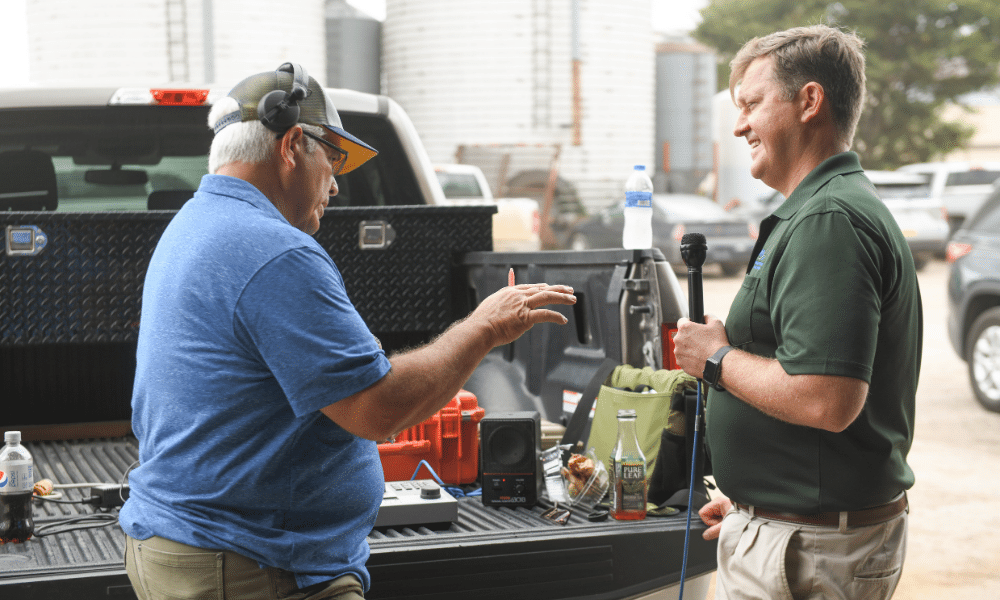
Sean McMahon, Executive Director of the Iowa Agriculture Water Alliance, visits with Bob Quinn during an WHO Big Show interview about Clean Water in Iowa Starts Here. (Joseph L. Murphy/Iowa Soybean Association)
Raising awareness in water quality
October 12, 2020
By Sean McMahon
The Iowa Agriculture Water Alliance is thrilled to partner with the Iowa Soybean Association (ISA), Iowa Department of Agriculture and Land Stewardship (IDALS), and WHO and WMT Radio on the Clean Water in Iowa Starts Here campaign. It aims to raise awareness of the roles all Iowans can play in improving water quality. One feature of the initiative are live broadcast remotes originating from farms throughout Iowa.
I was pleased to be back on Bill and Nancy Couser’s farm near Nevada for the third stop on the campaign. It was a beautiful day in mid-August to launch the brand new $33 million Iowa Systems Approach to Conservation Drainage project along with our partners at IDALS and the Natural Resources Conservation Service (NRCS).
The Couser farm is an exemplary model for conservation practices. From the site where we broadcast the show — at the headwaters of both Indian Creek and the West Branch of Indian Creek — we can gaze down an ample 200-foot grass buffer to a beautiful, restored stretch of meandering creek. Also within our view is dense timber teeming with birdlife, four saturated buffers and bioreactors, and a seven-acre patch of native prairie. As Bob Quinn of The Big Show observed, we could also see an ethanol plant, view several wind turbines and hear a nearby train.
And of course, we could see where the Cousers have implemented cover crops, no till, other forms of reduced tillage, drainage water management and innovative nutrient
stewardship practices, including a recent biological product designed to increase the amount of nitrogen available to the corn crop.
The Cousers are also measuring water quality. They have broken their farm down into four quadrants, each drained by different tile lines, to better understand how different management systems are impacting nitrogen and phosphorus levels.
The Cousers aren’t done yet. They’re also planning on installing two more bioreactors on their ‘AGvocacy Learning Farm.’
The Couser farm was very fitting to kick-off the new water quality campaign, because the Cousers are already taking a systems approach to agricultural productivity, profitability and water quality. We look forward to working with additional producers in north-central and central Iowa to adopt this systems approach.
Building off concepts developed by Dr. Mike Castellano and colleagues at Iowa State University, the Iowa Agriculture Water Alliance will help farmers better understand the interactions among subsurface agricultural drainage, in-field management practices and agricultural productivity and profitability. We’ll also seek to better integrate in-field management practices with edge-of-field conservation drainage practices. This approach will help farmers improve their bottom line, boost yields, reduce greenhouse gas emissions and improve water quality.
As farmers are considering upgrading their subsurface drainage, it is a great time to plan and design conservation drainage practices like drainage water management, saturated buffers, bioreactors or even wetlands.
Drainage water management can help farmers in years like the one we’re having right now, with a fairly wet spring followed by a very dry summer. Drainage control structures installed on tile lines can hold water back for the crops, enabling farmers to get a yield bump from those systems.
The Iowa Systems Approach to Conservation Drainage project is made possible by a $10 million grant from USDA-NRCS through the Regional Conservation Partnership Program (RCPP), which we are matching with $23 million in non-federal partner contributions.
The RCPP, first authorized in the 2014 Farm Bill, will target federal financial assistance to priority watersheds and landscapes and usher in a new era of public-private partnerships. In Iowa, we have done just that. This new RCPP includes 16 public and private sector partners. In 2016, IAWA and IDALS collaborated on the Midwest Agriculture Water Quality Partnership (MAWQP) RCPP. MAWQP has 48 partners, mostly from the private sector, and has helped improve conservation on more than 3.5 million acres. This includes helping pay for the bioreactors and saturated buffers the Cousers installed on their farm last year.
I had the privilege of announcing some ‘breaking news’ on The Big Show. The NRCS had just selected the MAWQP for renewal and would be providing an additional $10 million for the project. These new dollars will benefit farmers in priority watersheds, such as the North Raccoon, South Skunk and Cedar Rivers. The additional funding will help MAWQP expand from a $50 million project ($11 million from USDA and $39 million from non-federal partners) to a $100 million project ($21 million from USDA and $79 million from non-federal partners). MAWQP is now the biggest RCPP project in the nation.
It’s a special day when you get to announce $20 million in new grants for Iowa’s farmers to improve water quality! I’d like to thank NRCS, IDALS, ISA and the dozens of IAWA’s private sector partners who make these projects possible.
This story was originally published in the October 2020 issue of the Iowa Soybean Review.
Back